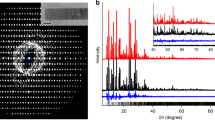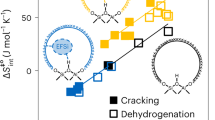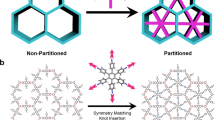Abstract
Stable aluminosilicate zeolites with extra-large pores that are open through rings of more than 12 tetrahedra could be used to process molecules larger than those currently manageable in zeolite materials. However, until very recently1,2,3, they proved elusive. In analogy to the interlayer expansion of layered zeolite precursors4,5, we report a strategy that yields thermally and hydrothermally stable silicates by expansion of a one-dimensional silicate chain with an intercalated silylating agent that separates and connects the chains. As a result, zeolites with extra-large pores delimited by 20, 16 and 16 Si tetrahedra along the three crystallographic directions are obtained. The as-made interchain-expanded zeolite contains dangling Si–CH3 groups that, by calcination, connect to each other, resulting in a true, fully connected (except possible defects) three-dimensional zeolite framework with a very low density. Additionally, it features triple four-ring units not seen before in any type of zeolite. The silicate expansion–condensation approach we report may be amenable to further extra-large-pore zeolite formation. Ti can be introduced in this zeolite, leading to a catalyst that is active in liquid-phase alkene oxidations involving bulky molecules, which shows promise in the industrially relevant clean production of propylene oxide using cumene hydroperoxide as an oxidant.
This is a preview of subscription content, access via your institution
Access options
Access Nature and 54 other Nature Portfolio journals
Get Nature+, our best-value online-access subscription
$29.99 / 30 days
cancel any time
Subscribe to this journal
Receive 51 print issues and online access
$199.00 per year
only $3.90 per issue
Buy this article
- Purchase on Springer Link
- Instant access to full article PDF
Prices may be subject to local taxes which are calculated during checkout



Similar content being viewed by others
Data availability
The datasets generated and/or analysed during the current study have been deposited in DIGITAL.CSIC (https://doi.org/10.20350/digitalCSIC/16103). Crystallographic parameters for the structures of ZEO-4A, ZEO-4B and ZEO-5 refined against synchrotron powder X-ray diffraction data (SPXRD) and continuous rotation electron diffraction (cRED) data are archived at the Cambridge Crystallographic Data Center (www.ccdc.cam.ac.uk/) under reference numbers 2249198 and 2249199 (ZEO-4A and ZEO-4B, SPXRD), 2249103–2249106 (ZEO-5A, ZEO-5B, ZEO-4A and ZEO-4B, cRED) and 2288122 (ZEO-5, combining cRED, SPXRD and neutron powder diffraction). Source data are provided with this paper.
References
Lin, Q.-F. et al. A stable aluminosilicate zeolite with intersecting three-dimensional extra-large pores. Science 374, 1605–1608 (2021).
Li, J. et al. A 3D extra-large-pore zeolite enabled by 1D-to-3D topotactic condensation of a chain silicate. Science 379, 283–287 (2023).
Morris, R. E. Clicking zeolites together. Science 379, 236–237 (2023).
Inagaki, S., Yokoi, T., Kubota, Y. & Tatsumi, T. Unique adsorption properties of organic–inorganic hybrid zeolite IEZ-1 with dimethylsilylene moieties. Chem. Commun. 48, 5188–5190 (2007).
Fan, W., Wu, P., Namba, S. & Tatsumi, T. A titanosilicate that is structurally analogous to an MWW-type lamellar precursor. Angew Chem. Int. Ed. 43, 236–240 (2004).
Smet, S. et al. Alternating copolymer of double four ring silicate and dimethyl silicone monomer–PSS-1. Chem. Eur. J. 23, 11286–11293 (2017).
Xu, L. & Sun, J. Recent advances in the synthesis and application of two-dimensional zeolites. Adv. Energy Mater. 6, 1600441 (2016).
Shamzhy, M., Gil, B., Opanasenko, M., Roth, W. J. & Čejka, J. MWW and MFI frameworks as model layered zeolites: structures, transformations, properties, and activity. ACS Catal. 11, 2366–2396 (2021).
Dawson, D. M., Moran, R. F. & Ashbrook, S. E. An NMR crystallographic investigation of the relationships between the crystal structure and 29Si isotropic chemical shift in silica zeolites. J. Phys. Chem. C Nanomater. Interfaces 121, 15198–15210 (2017).
Baerlocher, C. & McCusker, L. B. Database of Zeolite Structures (Structure Commission of the International Zeolite Association, accessed 23 March 2023); http://www.iza-structure.org/databases/.
Zheng, N., Bu, X., Wang, B. & Feng, P. Microporous and photoluminescent chalcogenide zeolite analogs. Science 298, 2366–2369 (2002).
Zicovich, C. M., Gándara, F., Monge, A. & Camblor, M. A. In situ transformation of TON silica zeolite into the less dense ITW: Structure-direction overcoming framework instability in the synthesis of SiO2 zeolites. J. Am. Chem. Soc. 132, 3461–3471 (2010).
Pophale, R., Cheeseman, P. A. & Deem, M. W. A database of new zeolite-like materials. Phys. Chem. Chem. Phys. 13, 12407–12412 (2011).
Eliášová, P. et al. The ADOR mechanism for the synthesis of new zeolites. Chem. Soc. Rev. 44, 7177–7206 (2015).
Mazur, M. et al. Synthesis of ‘unfeasible’ zeolites. Nat. Chem. 8, 58–62 (2016).
Li, J., Lin, C., Ma, T. & Sun, J. Atomic-resolution structures from polycrystalline covalent organic frameworks with enhanced cryo-cRED. Nat. Commun. 13, 4016 (2022).
Sheldrick, G. M. Phase annealing in SHELX-90: direct methods for larger structures. Acta Cryst. A46, 467–473 (1990).
Coelho, A. A. TOPAS and TOPAS-Academic: an optimization program integrating computer algebra and crystallographic objects written in C++. J. Appl. Cryst. 51, 210–218 (2018).
Petricek, V., Dusek, M. & Palatinus, L. Crystallographic computing system JANA2006: general features. Z. Kristallogr. 229, 345–352 (2014).
Koch, C. T. Determination of Core Structure Periodicity and Point Defect Density Along Dislocations. PhD thesis, Arizona State Univ. (2002).
Deem, M. W., Pophale, R., Cheeseman, P. A. & Earl, D. J. Computational discovery of new zeolite-like materials. J. Phys. Chem. C 113, 21353–21360 (2009).
Acknowledgements
Financial support from the Spanish Ministry of Science Innovation (PID2019-105479RB-I00 and TED2021-131223B-I00 Projects, MCIN/AEI/10.13039/501100011033 and grants RYC2018-024561-I and FJC2018-035697-I); the National Natural Science Foundation of China (grants 22371121, 22288101, 21920102005, 21835002, 22271115 and 52270111); the National Key Research and Development Program of China (grants 2022YFA1503600, 2021YFA1501202 and 2021YFA1501401); the 111 Project (grant B17020); the Fundamental Research Funds for the Central Universities of China (grant 020514380306); and the Consejería de Universidades, Investigación e Innovación, Junta de Andalucía (grant POSTDOC_21_00069) is gratefully acknowledged. Continuous rotation electron diffraction data were collected at the Electron Microscopy Center, Department of Materials and Environmental Chemistry at Stockholm University with the support of the Knut and Alice Wallenberg Foundation (grant 2012-0112) through the 3DEM-NATUR Project. We acknowledge the use of instrumentation provided by the National Facility ELECMI (Integrated Infrastructure for Electron Microscopy of Materials) ICTS (Instalación Científico Técnica Singular) node Laboratorio de Microscopías Avanzadas at the University of Zaragoza. Additional funding from the European Union’s Horizon 2020 Research and Innovation Program (grant 823717-ESTEEM3) and the Regional Government of Aragon (grant DGA E13_20R) is also acknowledged. H.Y. is grateful to the China Scholarship Council for a PhD grant. Synchrotron powder X-ray diffraction data experiments were performed at the MSPD (Materials Science Powder Diffraction) beamline bl04 at the ALBA Spanish Synchrotron with the collaboration of the ALBA staff. We thank C3UPO (Centro de Cálculo Científico de la Universidad Pablo de Olavide) for providing high-performance computing facilities and L.-H. He for help with the powder neutron diffractions data collection performed at the general purpose powder diffractometer of China Spallation Neutron Source, Dongguan, China (Project General Purpose Powder Diffractometer, P1823060200002).
Author information
Authors and Affiliations
Contributions
M.A.C. conceived the project. J.L., P.W., J.Y. and M.A.C. supervised this work. Z.R.G., H.Y., F.-J.C. and Zijian Niu performed the synthesis. C.M. and J.L. solved the structures, and J.H. and J.L. performed Rietveld refinement. A.M. performed the Cs-corrected STEM analysis. Z.R.G. analysed the topology. S.R.G.B. performed and analysed all computer calculations. Z.R.G., H.Y., F.-J.C., Zijian Niu, Ziwen Niu, H.D., C.M.-Á., H.X., W.F. and M.A.C. carried out the physicochemical characterization. S.X., Y.Z. and J.X. performed two-dimensional and dynamic nuclear polarization magic-angle spinning nuclear magnetic resonance spectroscopy. H.D. and H.H. worked on the volatile organic compounds adsorption. Ziwen Niu, X.L., H.X. and P.W. performed the catalytic tests. M.A.C. wrote the initial draft of the manuscript. J.L., P.W., J.Y. and M.A.C. organized the work and the draft. All the authors discussed the results and revised the manuscript.
Corresponding authors
Ethics declarations
Competing interests
The authors declare no competing interests.
Peer review
Peer review information
Nature thanks Alex Yip and the other, anonymous, reviewer(s) for their contribution to the peer review of this work. Peer reviewer reports are available.
Additional information
Publisher’s note Springer Nature remains neutral with regard to jurisdictional claims in published maps and institutional affiliations.
Extended data figures and tables
Extended Data Fig. 1 Field emission scanning electron microscopy.
FESEM images of ZEO-4A (a), ZEO-4B (b), ZEO-5A (c), and ZEO-5B (d), showing the same morphology of ZEO-22.
Extended Data Fig. 2 Zeolite porosity.
The pores in fully connected framework ZEO-5 (a-b) and interrupted structure ZEO-4A (c-d) and ZEO-4B (e-f), the 20-ring pore (a, c, e) approximately along [001] and the 16-ring pore (b, d, f) approximately along [110].
Extended Data Fig. 3 Rietveld structure refinement.
Rietveld refinement plots of (a) ZEO-4A and (b) ZEO-4B against SPXRD (λ = 0.61928 Å).
Extended Data Fig. 4 29Si MAS NMR spectroscopy.
29Si MAS NMR spectra of ZEO-5 (from bottom): Experimental, DFT-simulated and individual components (see SM). The DFT study confirms that the very low field signal at −98 ppm corresponds to the Si sites in the central 4-ring of the t4r unit (Si12 and Si13).
Extended Data Fig. 5 Cs-corrected STEM analysis of the pore systems.
Along [110] (a-c) for a) ZEO-4A b) ZEO-4B and c) ZEO-5 with the units involved in the structural transformation circumscribed by yellow dashed ellipses. Condensation of ZEO-4A and ZEO-4B into ZEO-5 brings about an expansion of the interchain distance, as shown by the yellow solid lines and in full agreement with the refined structures. In d) the 20 R pore of ZEO-5 is observed along the [001] projection. A t4r unit is marked by a green dashed ellipse. The micrographs simulated using the Rietveld refined data are shown in the insets and corroborate the structural models.
Extended Data Fig. 6 Thermal and hydrothermal stability tests for ZEO-5.
PXRD patterns of ZEO-4A (a), and ZEO-5 upon calcination at 600 °C (b), 800 °C (c), and 1000 °C (d) with one-hour plateau, and ZEO-5 steamed at 760 °C for 3 h under 10% H2O (e).
Extended Data Fig. 7 Catalytic oxidation of propylene.
Dependence of PO yield (A) and specific PO yield per Ti site (B) on reaction time over Ti-ZEO-5 (a) and Ti-HMS (b) catalysts in the propylene epoxidation reaction. Reaction conditions: catalyst, 0.01 g; cumene hydroperoxide (CHP), 10 mmol; propylene, 100 mmol; cumene solvent, 10 mL; temp., 373 K; reaction pressure, 2.4 MPa.
Extended Data Fig. 8 Framework density – Energy plot.
The lattice energy versus density of the zeolite-like materials (black dots) was minimized using the Sanders-Leslie-Catlow (SLC) interatomic potential, according to Deem et al.21 The red line appears in the original publication as “the linear fit of energy versus density for the known zeolite structures.” We have included our data points for updated porous crystalline silica polymorphs from the IZA database (red points), dense silica polymorphs (green points), and ZEO-1, ZEO-3, and ZEO-5 materials (large blue points) calculated using the same methodology. Reprinted (adapted) with permission from ref. 21, copyright 2009 American Chemical Society.
Supplementary information
Supplementary Information
This file contains Supplementary Figs. 1–25, Tables S1–S27 and references.
Supplementary Data (Source Data Supplementary Fig. 8)
Ar adsorption/desorption isotherms of ZEO-4 and ZEO-5 at 87 K.
Supplementary Data (Source Data Supplementary Fig. 9)
Toluene adsorption on largely porous zeolites.
Supplementary Data (Source Data Supplementary Fig. 10)
1H, 13C and 31P liquid NMR spectra of as-synthesized OSDACl and the OSDA recovered from the filtrated solution of ZEO-4A and ZEO-4B after IChEZ treatments.
Supplementary Data (Source Data Supplementary Fig. 11)
FTIR of ZEO-4 and ZEO-5, A and B.
Supplementary Data (Source Data Supplementary Fig. 12)
13C and 31P MAS NMR spectra of ZEO-4A and ZEO-4B after the IChEZ reaction.
Supplementary Data (Source Data Supplementary Fig. 13)
1H MAS NMR of ZEO-4.
Supplementary Data (Source Data Supplementary Fig. 14)
29Si–1H CP MAS NMR of ZEO-4A.
Supplementary Data (Source Data Supplementary Fig. 15)
29Si–1H CP MAS NMR of ZEO-4B.
Supplementary Data (Source Data Supplementary Fig. 16)
1H–29Si HETCOR MAS NMR spectra of ZEO-4A at short (500 μs) and long (5000 μs) contacting time.
Supplementary Data (Source Data Supplementary Fig. 17)
1H–29Si HETCOR MAS NMR spectra of ZEO-4B at long contact time (6 ms).
Supplementary Data (Source Data Supplementary Fig. 18)
1H MAS NMR of ZEO-5A.
Supplementary Data (Source Data Supplementary Fig. 19)
1H DQ-SQ MAS NMR spectra of ZEO-5A.
Supplementary Data (Source Data Supplementary Fig. 20)
29Si MAS NMR of ZEO-5A.
Supplementary Data (Source Data Supplementary Fig. 21)
29Si–1H MAS NMR of ZEO-5A.
Supplementary Data (Source Data Supplementary Fig. 22)
1H–29Si HETCOR MAS NMR spectra of ZEO-5A at short (1,500 μs) and long (5,000 μs) contacting time.
Supplementary Data (Source Data Supplementary Fig. 23)
EPR spectra of ZEO-5.
Supplementary Data (Source Data Supplementary Fig. 24)
Cycloctane adsorption.
Supplementary Data (Source Data Supplementary Fig. 25)
PXRD of catalysts.
Rights and permissions
Springer Nature or its licensor (e.g. a society or other partner) holds exclusive rights to this article under a publishing agreement with the author(s) or other rightsholder(s); author self-archiving of the accepted manuscript version of this article is solely governed by the terms of such publishing agreement and applicable law.
About this article
Cite this article
Gao, Z.R., Yu, H., Chen, FJ. et al. Interchain-expanded extra-large-pore zeolites. Nature 628, 99–103 (2024). https://doi.org/10.1038/s41586-024-07194-6
Received:
Accepted:
Published:
Issue Date:
DOI: https://doi.org/10.1038/s41586-024-07194-6
Comments
By submitting a comment you agree to abide by our Terms and Community Guidelines. If you find something abusive or that does not comply with our terms or guidelines please flag it as inappropriate.



